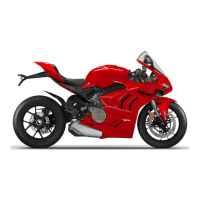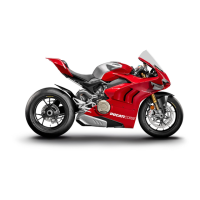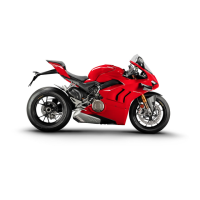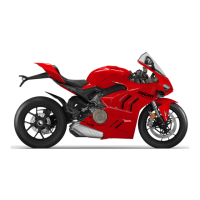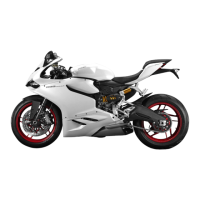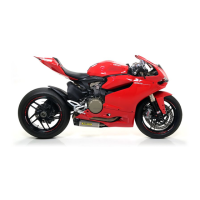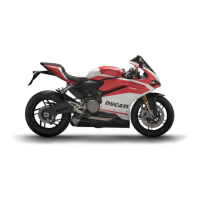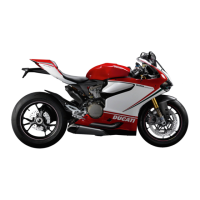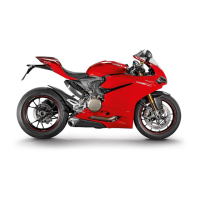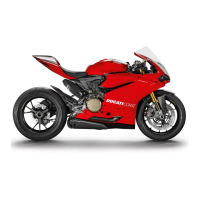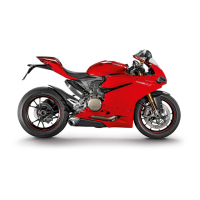Do you have a question about the Ducati PANIGALE and is the answer not in the manual?
Details Ducati's warranty terms and conditions for new motorcycles, covering coverage and limitations.
Specifies how the motorcycle is designed to be used and its limitations on surfaces and conditions.
Outlines the responsibilities of the motorcycle rider, including licensing and legal requirements.
Provides essential safety tips for operating the motorcycle, covering pre-ride checks and general riding practices.
Specifies the maximum load capacity and weight distribution guidelines for safe riding.
Identifies the location of major motorcycle components and devices via numbered illustrations.
Explains how to adjust the front fork for rebound, compression, and spring preload.
Details how to adjust the rear shock absorber for damping and spring preload.
Illustrates and identifies the location of all motorcycle controls for rider interface.
Explains the function of various switches on the left and right handlebar controls.
Information on the motorcycle keys, immobilizer system, and procedures for duplicate keys.
Procedure to temporarily restore operation if key acknowledgement fails using a PIN code.
Provides guidelines for the initial break-in period, including maximum rotation speeds and gentle braking.
Lists essential checks to perform before riding, covering fuel, oil, fluids, tires, controls, and lights.
Explains the correct procedure for starting and stopping the engine using the ignition switch and kill switch.
Details the steps for safely starting to ride the motorcycle, including clutch and gear engagement.
Provides advice on effective braking techniques, including engine braking and using both brakes.
Explains how the ABS system functions to prevent wheel lockup and preserve traction.
Details the procedure for safely bringing the motorcycle to a complete stop.
Instructions on how to park the motorcycle safely, including using the side stand and steering lock.
Overview of the instrument panel, detailing its numbered indicators and displays.
Explains how to set and display various parameters, including riding modes and their configurations.
Explains the three riding modes (Race, Sport, Street) and their parameter associations.
Describes the Ducati Wheelie Control indicator, its levels, and operation.
Explains the ABS indicator status, self-diagnosis, and performance degradation.
Details the Ducati Traction Control indicator and its intervention levels.
Explains the Ducati Quick Shift indicator and its operation for up/down shifting.
Describes the Engine Braking Control indicator and its levels.
Allows customization of parameters for each riding mode (Race, Sport, Street).
Customizes engine power settings (High, Medium, Low) for each selected riding mode.
Sets the ABS level (1-3) for each selected riding mode.
Disables or sets the Ducati Wheelie Control level (1-4, Off) for riding modes.
Sets the Engine Braking Control level (1-3) for each selected riding mode.
Allows activation or modification of the motorcycle's 4-digit PIN code.
Guides on setting a new 4-digit PIN code for the motorcycle.
Explains how to enter the old PIN to change the existing PIN code.
Allows calibration of tire rolling circumference and final drive ratio.
Explains how to check brake pad wear through the caliper inspection hole.
Provides instructions for removing the battery from the motorcycle and charging it.
Lists maintenance operations to be performed by authorized Ducati dealers at specified intervals.
Provides detailed technical specifications of the engine, including bore, stroke, and displacement.
Provides technical details on the front and rear brake systems, including disc specifications.
Details gearbox ratios, clutch type, and drive chain specifications.
Details Ducati's warranty terms and conditions for new motorcycles, covering coverage and limitations.
Specifies how the motorcycle is designed to be used and its limitations on surfaces and conditions.
Outlines the responsibilities of the motorcycle rider, including licensing and legal requirements.
Provides essential safety tips for operating the motorcycle, covering pre-ride checks and general riding practices.
Specifies the maximum load capacity and weight distribution guidelines for safe riding.
Identifies the location of major motorcycle components and devices via numbered illustrations.
Explains how to adjust the front fork for rebound, compression, and spring preload.
Details how to adjust the rear shock absorber for damping and spring preload.
Illustrates and identifies the location of all motorcycle controls for rider interface.
Explains the function of various switches on the left and right handlebar controls.
Information on the motorcycle keys, immobilizer system, and procedures for duplicate keys.
Procedure to temporarily restore operation if key acknowledgement fails using a PIN code.
Provides guidelines for the initial break-in period, including maximum rotation speeds and gentle braking.
Lists essential checks to perform before riding, covering fuel, oil, fluids, tires, controls, and lights.
Explains the correct procedure for starting and stopping the engine using the ignition switch and kill switch.
Details the steps for safely starting to ride the motorcycle, including clutch and gear engagement.
Provides advice on effective braking techniques, including engine braking and using both brakes.
Explains how the ABS system functions to prevent wheel lockup and preserve traction.
Details the procedure for safely bringing the motorcycle to a complete stop.
Instructions on how to park the motorcycle safely, including using the side stand and steering lock.
Overview of the instrument panel, detailing its numbered indicators and displays.
Explains how to set and display various parameters, including riding modes and their configurations.
Explains the three riding modes (Race, Sport, Street) and their parameter associations.
Describes the Ducati Wheelie Control indicator, its levels, and operation.
Explains the ABS indicator status, self-diagnosis, and performance degradation.
Details the Ducati Traction Control indicator and its intervention levels.
Explains the Ducati Quick Shift indicator and its operation for up/down shifting.
Describes the Engine Braking Control indicator and its levels.
Allows customization of parameters for each riding mode (Race, Sport, Street).
Customizes engine power settings (High, Medium, Low) for each selected riding mode.
Sets the ABS level (1-3) for each selected riding mode.
Disables or sets the Ducati Wheelie Control level (1-4, Off) for riding modes.
Sets the Engine Braking Control level (1-3) for each selected riding mode.
Allows activation or modification of the motorcycle's 4-digit PIN code.
Guides on setting a new 4-digit PIN code for the motorcycle.
Explains how to enter the old PIN to change the existing PIN code.
Allows calibration of tire rolling circumference and final drive ratio.
Explains how to check brake pad wear through the caliper inspection hole.
Provides instructions for removing the battery from the motorcycle and charging it.
Lists maintenance operations to be performed by authorized Ducati dealers at specified intervals.
Provides detailed technical specifications of the engine, including bore, stroke, and displacement.
Provides technical details on the front and rear brake systems, including disc specifications.
Details gearbox ratios, clutch type, and drive chain specifications.
| Displacement | 1103 cc |
|---|---|
| Transmission | 6-speed |
| Front Suspension | Öhlins NPX25/30 43 mm fully adjustable fork with electronic compression and rebound damping adjustment |
| Rear Suspension | Öhlins TTX36, fully adjustable |
| Front Brake | Dual 330mm discs, Brembo Stylema monobloc calipers |
| Rear Brake | 245 mm disc, 2-piston caliper with ABS Cornering EVO |
| Fuel Tank Capacity | 4.2 gallons (16 liters) |
| ABS | ABS Cornering EVO |
| Traction Control | Ducati Traction Control (DTC) EVO |
| Seat Height | 32.9 inches (835 mm) |
| Power | 214 hp (157 kW) @ 10, 750 rpm |
